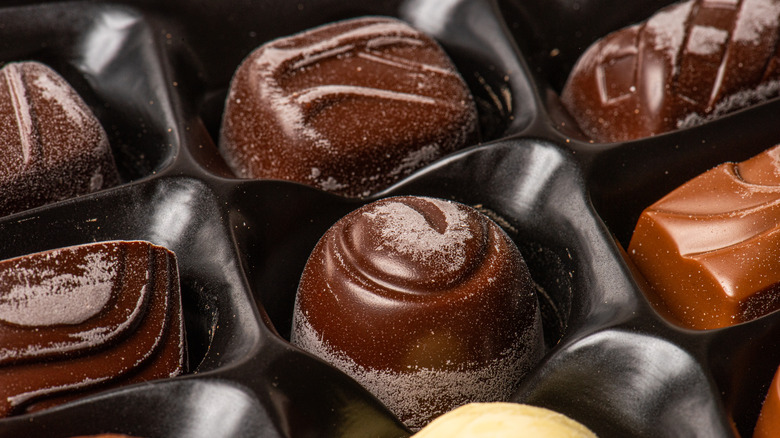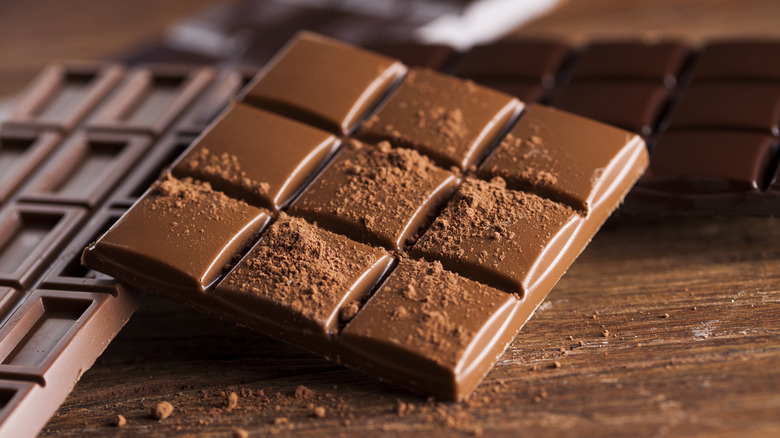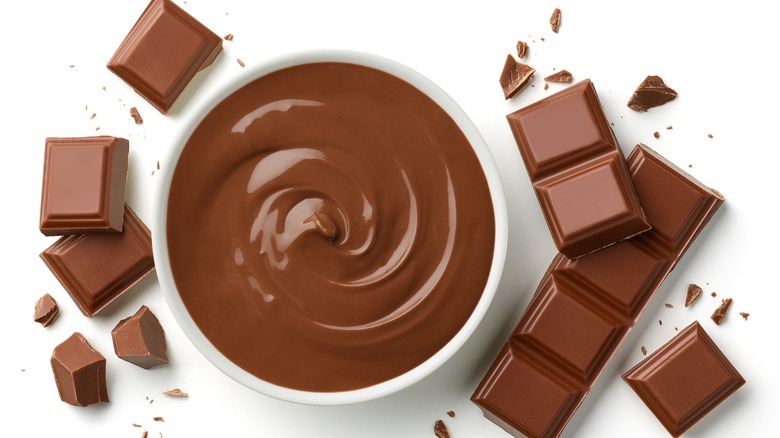What Is The White Coating On Chocolate Bars, And Is It Safe To Eat?
There are several things you can expect when opening a good bar of chocolate or a box of bonbons: A gentle aroma, a crisp snap when you break it, a smooth texture when you feel it under your fingers, and a glossy sheen on its surface. What you certainly do not expect are streaks of grey, patches of white, and swirls of discoloration on what should be a shiny piece of chocolate.
This layer of whitish discoloration on otherwise dark and light brown bars of chocolate is known as chocolate bloom. The bloom that appears on chocolate is one of two kinds: a fat bloom or a sugar bloom. Fat blooms come in the form of grey or light brown patches of discoloration that give the chocolate a paler appearance that cookbook author Nik Sharma says (via Bon Appétit) resembles "the surface of the moon." Chocolates can also develop what's known as a sugar bloom, which dots the bars with specs of white that are more powdery in appearance.
Regardless of the type of bloom that may be coating your chocolate, it's still perfectly safe to eat the sweet confectionery. Bloom neither affects the taste of the chocolate nor its shelf life — the only pesky things it does are make the chocolate look a tad unappetizing and make its texture feel more grainy.
What causes bloom to appear on chocolates?
Depending on its type, bloom can appear on chocolate bars for different reasons. Fat blooms typically appear due to improper storage or incorrect tempering. Chocolates undergo the process of tempering wherein confectioners heat and cool melted chocolate at carefully controlled temperatures to evenly distribute cocoa butter throughout. Tempering is what stabilizes the chocolate and gives it a glossy shine and a sharp snap. Fat bloom is usually a sign of chocolate that hasn't been tempered properly — or was stored in hot conditions that may have caused the cocoa butter to melt prematurely and solidify again as bloom on the chocolate's surface.
Sugar bloom, on the flip side, appears when chocolate has been stored in conditions that are too humid. Humidity melts the sugar present in the chocolate, which settles as bloom on the surface as it solidifies again. Transferring chocolate from one drastic temperature to another can also cause sugar bloom. As chocolate adjusts to the temperature shock, condensation appears on its surface — which then reacts with sugar to form a coating of bloom.
In most cases, the bloom on chocolate bars appears due to incorrect tempering on the chocolate maker's part or improper temperature while the chocolate is transported and stored. If the chocolate was fine when you first opened it, and the half-eaten bar suddenly seems to have developed a layer of bloom overnight, it's likely that you didn't store the chocolate properly.
How can you prevent chocolate from blooming?
The best way to prevent a coating of bloom from appearing on chocolate is to store it at a cool and constant temperature in air-tight containers. Heat and moisture tend to be chocolate's enemies, so it's best to keep it in a dark and dry cupboard rather than in refrigerators with higher levels of condensation.
If the chocolate already has bloomed, fret not — you can still eat it. You could pop the chocolate in your mouth as it is or melt and re-temper it to get rid of the bloom. Alternatively, you could keep the bloomed chocolate for recipes that require you to use melted chocolate, as that gets rid of the bloom anyway — think cookies, ganache, and mousse. In any case, bloom doesn't mean that chocolate has gone bad. In fact, chocolate doesn't have the watery, damp conditions that are necessary for mold to grow, and it's fairly rare for chocolate to even go bad.
That being said, smell is a better indicator of inedible chocolate, and anything that smells suspiciously savory may be a sign of chocolate that's gone bad. You could always taste a small shard of the chocolate, and if it happens to be a little more bitter than it's supposed to be, chances are that it's a sign of spoilage. Regardless of how you discern the freshness of your chocolate, don't go by the white coating on it, as that bloom will cause no harm beyond affecting the appearance and texture of the chocolate.



